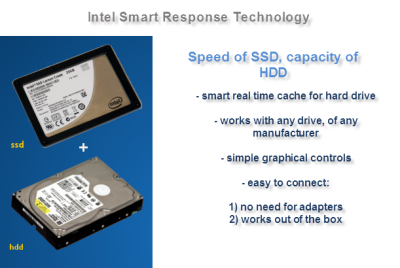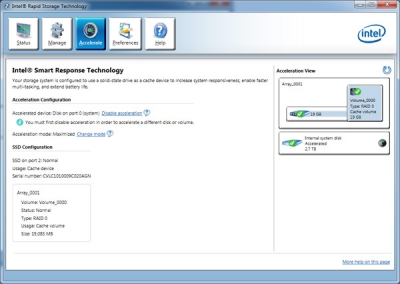SSD is not a rarity any more and can be frequently seen in home computers. Users often create a system volume on it, install OS and heavy software (they say that even Photoshop runs like crazy on it) and keep on storing music and movies on hard drives.
In servers, when fast database work is required, you can order SSD as carrier and after doing that databases become live. Until there is no space left on SSD. Then users order cunning RAID arrays or collect clusters.
In 2011 Intel company presented to those in need for speed a technology called Smart Response Technology (SRT), that uses SSD as caching buffer between RAM and hard drive. You can use SSD with capacity up to 64Gb, and not the files are being cached, but accessed logical blocks from hard drive and if SSD is suddenly filled up, then cells that have not been accessed for a long time period will start filling in with new data. This SRT works like Linux works with RAM.

So now everything is clear with reading. In case of writing things are far more interesting and there are two usage modes: fastest possible and expanded. In expanded mode the data is written simultaneously to both SSD and hard drive. This mode is slower than the former but is reliable and guarantees that data will be saved on hard drive whatever happens. Naturally, data is saved to SSD at the next accessing, system receives them very fast.
In optimized for speed mode data is first saved to SSD and then to hard drive with a certain delay, whenever it is convenient (called ‘lazy writing’). In this mode the speed of saving data is only limited by the writing speed to SSD, but data integrity is not guaranteed — there is a chance of power supply failure during the writing process (which is not relevant for laptops) or, all of a sudden, SSD crashes, in this case part of data that was not written to hard drive will be lost. The behaviour of this mode reminds me of Redis: fast, smart and secure enough, but has to be used very carefully.
Caching is realized via RAID array, in which you need to add hard drive and SSD in BIOS and you need to clearly specify SSD as a caching device. Such option is in BIOS on motherboards with chip set Z68.
You need only to turn on caching in BIOS and then immediately forget how to access this scary place. Intel makes products for people and that is why caching is set in the system itself with the help of simple graphic tool:

If in the work process SSD suddenly fails, then if there were no writes in fast mode, the user won’t notice anything: SSD will fall off and everything will start working very slow, you will have a feeling of shifting from LAN to dial-up.
But using only SSD read/write speed would be a blasphemy, second huge bonus is hidden in non-volatility. It means that after rebooting data will remain in cache and if you frequently run Photoshop then it will start slow only for the first time and all other times it will start fast, even after rebooting.

 The essence of computer has changed a lot during the last decade, but not all bottlenecks have been removed from it. One of such bottlenecks is a hard drive. Its because of it that operating system often cannot boot from a cold start for 10 seconds. There is SSD, but using it as main storage is difficult due to small capacity. So it means that SSD cannot crack the modern architecture: there is slow storage and fast random-access memory.
The essence of computer has changed a lot during the last decade, but not all bottlenecks have been removed from it. One of such bottlenecks is a hard drive. Its because of it that operating system often cannot boot from a cold start for 10 seconds. There is SSD, but using it as main storage is difficult due to small capacity. So it means that SSD cannot crack the modern architecture: there is slow storage and fast random-access memory.